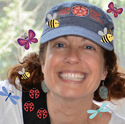Love Thy Pollineighbor – August 2017
Monarch butterflies have been on earth for roughly 175 million years, but it’s only since the 1990’s that their numbers have declined by 80%. In 25 short years, 560 of the 700 million Monarch butterflies in North America have disappeared.
Being in the presence of a Monarch has brought me great joy for as far back as I can remember. Is it their stunning, fiery, brilliance that lights up trees and the sky? Could it be the unique patterning making them the most familiar butterfly in history? Maybe. But mostly I love them because they are an unmistakable symbol of perseverance and transformation. These remarkable little beings have a migration like no other. Each fall one generation travels 3000 miles to sustain their existence on earth. They endure the most difficult situations on that journey—strong winds, heavy rains in some places, drought in other places, lack of food, lack of shelter, and so on. Then, in spring, their offspring make the trek back to the same places from which their ancestors came.
They persist despite the arduous journey, miraculous metamorphosis, and mysterious migration. But their battle does not end with seeking food, water, and shelter. They have much more than the daily survival-related obstacles with which to grapple. They also have to battle multinational, multibillion-dollar, agrochemical companies.
The Monarch, a stunning example of nature’s mystique and resolve has survived millions of years through the ice age, the Stone Age, and the industrial age, but is no contest for the habitat destruction and 1 billion pounds of pesticides used each year in the US alone. These resilient and iconic winged beings are losing the battle to human activity.
What can you do to help the Monarch Butterfly?
AVOID using synthetic pesticides (herbicides and insecticides)—One day perhaps I’ll write about our recent visit to France and the beautiful weeds we saw along the roadsides and sidewalks, in town centers, parks, and in yards. The French government and people are taking a stand for the pollinators (seemingly driven by a need to protect bees given their great affinity for honey) with a general ban on pesticides for domestic use. When a community unites and stops adding toxic elements to their environment, they are choosing health over convenience and a future for their children’s children that includes the magic and charm of a fluttering natural world. At the current rate in North America, the unborn generations will only know about Monarch butterflies through books.
So, despite the recommendations of some, when millions of households use poisons as a tool for dealing with nuisance pests and weeds, the outcome has a widespread and lasting impact. Pesticides are not the solution that will help our dirty air, dying soil, befouled water, and suffering wildlife. According to the U.S. Fish and Wildlife Service, homeowners use up to 10 times more chemical pesticides per acre on their lawns than farmers use on crops. Homeowners now share culpability with agriculture for pollinator decline. Weed killers and insecticides are tainting pollen that bees are bringing back to their hives and nests. They’re losing their way: A growing body of research suggests that, even at non-lethal doses, pesticides can disrupt bee navigation thus not finding their nests and hives. And pesticides make pollinators vulnerable to stress and disease prematurely killing them.
Pesticides are also destroying vital habitat for our beneficial insects. These problems are not limited to neonicotinoids and glyphosate (active ingredient in Roundup). Studies are showing the combined effect of different pesticides from various sources can increase or intensify when these chemicals interact with one another.
The Jackson County Master Gardeners have a recipe for making your own vinegar-based alternative to RoundUp that is just as convenient, less expensive, and less toxic:
- 1 gallon 10% vinegar (I’ve used 5% with success)
- 1 cup of salt
- 2 tsp Dawn dish soap or vegetable oil (to make it adhere to the plant)
- Mix and spray
GROW native milkweed and forage plants—Monarchs only lay eggs on their host plant, milkweed. No milkweed, no Monarchs. A Monarch mama-to-be will die looking for milkweed. If she finds it, she has roughly 300 eggs to lay. If she doesn’t, the earth loses 300 Monarch baby caterpillar opportunities. By growing milkweed, you will help this vital butterfly, an internationally-known ambassador of the earth, survive. Grow native milkweed from seeds or find plants at your local nursery. Some nurseries still spray their plants, so please ask before you purchase.
Check out the Beekman Native Plant Arboretum to see the bumper crop of Showy Milkweed or take a stroll along Mary Ann Drive (about 1/10 of a mile from 238 on the left side) to see a small crop of Narrowleaf milkweed—both are natives.
Provide forage flowers for the adult Monarchs. With milkweed and forage flowers, you can create and certify a Monarch Waystation! Some Monarch flower favorites include:
- Native milkweeds (a host and forage)
- Coyote Mint
- Giant Hyssop
- Foxglove Beardtongue
- Wild buckwheat
- Western Goldenrod
- Rubber Rabbitbrush
- Asters
- Oceanspray
- Dwarf Butterfly Bush (this is a noninvasive butterfly bush)
To learn more about protecting our native pollinators like creating a certified Monarch Waystation, come to Jacksonville’s first pollinator event on August 6 during the J’Ville Market on the Courthouse/City Hall lawn. Pollinactivists will be on hand to answer questions and share their joy for bees and butterflies from 9:00am-1:00pm.

 When she’s not working, volunteering, fiddling about the garden, photographing nature, being a pollinactivist, blogging about social and environmental justice, or pawning her eco-children’s book, Kenda, a former Monarch butterfly docent, gets her kicks hanging with her husband, her dog, and the pollineighbors.
When she’s not working, volunteering, fiddling about the garden, photographing nature, being a pollinactivist, blogging about social and environmental justice, or pawning her eco-children’s book, Kenda, a former Monarch butterfly docent, gets her kicks hanging with her husband, her dog, and the pollineighbors.